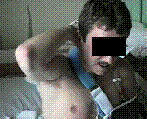
- Discussion of Treatment of Recent Dislocations and Fracture-Dislocations of the Shoulder
- maintains that biceps and subscapularis muscle offers the chief resistance to reduction;
- in anatomic position, w/ humerus at side, direction of various muscles around shoulder girdle seems to completely haphazard;
- constancy of this effect must be attributed to the stress exerted by external rotation of the whole arm against the internal rotatory action of subscapularis, acting upon lesser tuberosity;
- where the magnitude of this force exceeds the strength of the bone, fracture takes place;
- when the arm is placed in the overhead or fully abducted position, entirely different situation is created;
- of all the positions which the humerus may assume, the overhead position is the only one in which all these muscles run in the same general direction;
- resultant of the shoulder muscles is coaxial with the humerus, and the transverse or fracturing component is reduced to zero;
- it is the only position in which a single force, exerted along the axis of the humerus, is accurately directed to overcome each and all of the muscle actions at the same time;
- for this reason, it has been chosen as the position in which reduction of dislocation of the shoulder should be undertaken, in preference to the antatomical position employed by Kocker;
- formal technique:
- pt lies in the supine position, while the surgeon takes his position on the same side of the dislocation;
- in a right sided dislocation the surgeon places his right hand upon pt's right shoulder, so that the fingers find firm support on the top of the shoulder, while the thumb is braced against dislocated humeral head;
- right hand fixes the head as the left hand gently abducts the arm into the overhead position;
- during this maneuvre the head of the humerus is supported so that it cannot move from its dislocated position;
- as consequence, instead of moving downward as the arm moves upward head rotates in place;
- in this manner the tendency to further stretch nerves and vessels is obviated;
- once the arm has been brought into complete abduction in this overhead position, all cross stresses exerted by all the muscles have been eliminated;
- head can be gently pushed over rim of glenoid, & dislocation reduced;
- arm is abducted and externally rotated;
- M.D.'s thumb is used to gently push head of humerus back into place;
- patient may either be supine or prone for this technque;
- Modifications:
- external rotation:
- of arm presents the thinnest profile of the humeral head to glenoid and tilts the greater tuberosity backwards, thus allowing the head to slide more easily back into appropriate anatomical position;
- scapular manipulation technique:
- the patient is placed in the supine position;
- an assistant uses one hand to push the inferior tip of the scapula medially (and to anchor it in this position) while reaching the other hand across the thorax inorder to prevent the patient from moving;
- the standard Milch technique is then applied;
- surgeon's thumb:
- which is applied to the undersurface of the dislocated humeral head, is used to push the humeral head laterally and helps guide it into reduction
Technical note: modifications and improvements of the Milch technique for the reduction of anterior dislocation of the shoulder without premedication.
A comparison of the Milch and Kocher techniques for acute anterior dislocation of the shoulder.
Reduction of acute anterior shoulder dislocations using the Milch technique: a study of ski injuries.
Painless reduction of acute anterior shoulder dislocations without anesthesia.

